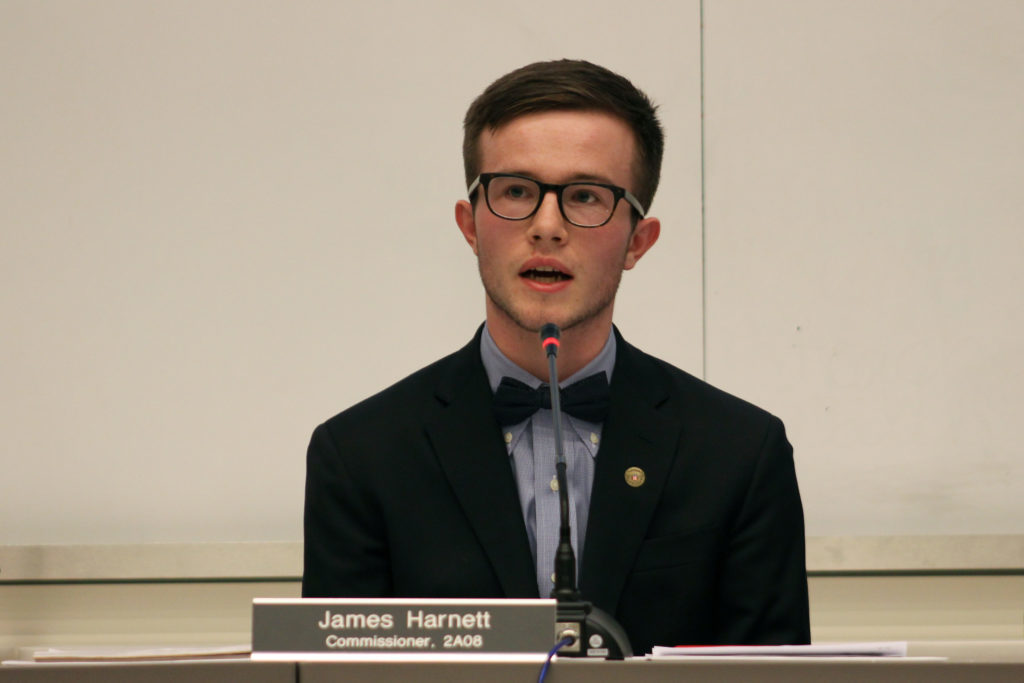A proposal for a bike lane that would cut through campus elicited mixed views from community members at a local neighborhood group meeting last week.
A transportation official proposed a plan at an Advisory Neighborhood Commission meeting last week to build bike lanes on either 20th, 21st or 22nd street that would stretch through Dupont Circle and GW’s campus and extend to the National Mall. Community members were divided about the proposal, which some said would diminish parking options on heavily trafficked streets, but others said would make bicycling on D.C. streets safer.
Terry Owens, the director of communications for the District Department of Transportation, said regardless of which street officials choose, the project will connect to a two-way protected bike lane on a section of 21st Street leading to the National Mall. Owens said the department has discussed the project with community members in the areas the bike lanes would affect.
“The project is just getting started, so we are focusing on discussing the existing conditions and the purpose and need for the project at this stage,” Owens said.
He said a bike lane connecting Dupont Circle to the National Mall has been proposed twice before in 2005 and 2014, as officials attempted to promote safer travel and combat climate change – but no concrete action has been taken on the proposal until now.
He said there will be a public meeting May 23 to introduce a draft of the design, a project timeline and the preliminary evaluations of the streets. DDOT hopes to have a “recommended alignment” by late 2018 or early 2019, Owens said.
Commissioners at the meeting agreed that 20th Street would be best suited to accommodate a new bike lane because it is wider and less residential than the other proposed streets, especially 22nd Street.
James Harnett, a Foggy Bottom and West End Advisory Neighborhood commissioner and sophomore, said the most effective bike lane plan would be a path on 20th Street because it would avoid the majority of pedestrian traffic on campus as students come and go from class.
“It’s an important tool to not only boost pedestrian safety or to enhance pedestrian safety but also to build an avenue for bicyclists to be able to safely get from one part of the city to another,” he said.
Harnett said he supports the proposal but wants to consult with students before a final decision is made, because the bike route will cut through campus and likely affect students as they walk on campus.
“Bicyclists often will speed through intersections if they don’t see vehicles and it’s a lot harder to spot pedestrians especially when there’s parked cars around,” he said.
Harnett said DDOT plans to host experts, commissioners and community members at a meeting in May to further discuss details of the project, like the orientation of the lanes, how many bike lanes will line the streets and if there will be a barrier between the lanes and vehicle traffic.
Sara Maddux, the West End Citizens Association secretary and treasurer, said at the meeting the Foggy Bottom area has limited residential parking on the proposed streets, especially on 21st Street, so the neighborhood can’t afford to give up those spots for a bike lane. The metered parking spots are essential to provide spaces for people like maintenance workers, she added.
“People who come and service these buildings need a place to park,” she said. “We are going to do everything we can to stop this from happening on 21st Street.”
Maddux said there are too many delivery trucks that drive on the already-narrow streets, and bicyclists don’t respect drivers and pedestrians when they weave between cars and cross streets regardless of traffic signals.
“You’re inviting a mobbed crowd into our neighborhood,” Maddux said. “We don’t want it. We’ve been here for years, and we’d like to maintain our neighborhood.”
Chris Labas, a community member who attended the meeting, said in an interview he uses his bike as his primary form of transportation around the District, and a bike lane connecting Dupont Circle to the National Mall is essential for cycler’s safety because cyclists become invisible to cars without a track.
“It’s frightening right now,” Labas said. “Cars travel at high speeds, cabs don’t pay attention and out-of-state drivers are the worst even when there are bike lanes, simply because they are unaware of how to navigate around the lanes.”
He added that because the D.C. population has increased greatly since 1985, many community members are realizing the usefulness of bikes in getting around the city.
“This beautiful city is perfect for cycling and bike lanes are inevitable and necessary,” Labas said. “We all need to work together from a place of practicality, mutual respect and cooperation.”




